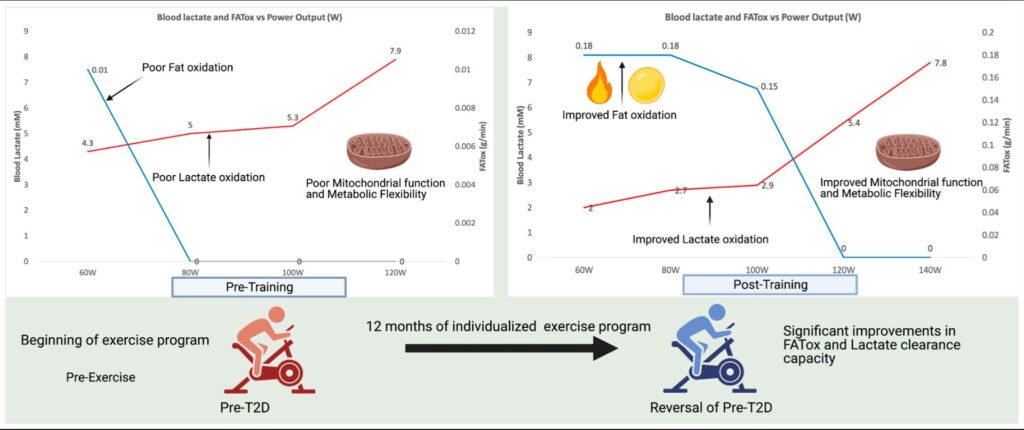Mitochondrial health is key to health and disease Skeletal muscle plays an instrumental role in mitochondrial function in both health and disease as it is the most bioenergetically active organ with the highest mitochondrial content. mitochondrial dysfunction has traditionally been linked to type 2 diabetes, it is also a hallmark of multiple diseases, including cardiovascular disease, cancer, and Alzheimer’s disease. – Inigo San-Millan
How do you measure mitochondrial function?
Well-trained athletes are known to have the highest functioning mitochondria of any humans. Elite endurance athletes are highly metabolically flexible; meaning, they can metabolize energy well from both carbohydrates and fat. One test of mitochondrial function is to measure the rate of fatty acid oxidation, i.e. what is the maximum amount of fat you can oxidize. Fat only oxidized in the mitochondria, so this would give a powerful insight in the performance of your mitochondria.
The only way to improve the rate of fat oxidation is through exercise. Specifically, exercise that maximally stresses the mitochondria at the point of maximal fat oxidation. San-Millan and George Brooks studied this in a paper1 that measured fat oxidation and lactate clearance capacity on a patient diagnosed with pre-type 2 diabetes. The patient was given a 12-month individualized exercise prescription. After completion of the program, the patient showed reversal of pre-diabetes and the patient showed significant improvements in fat oxidation and lactate clearance capacity (lactate is cleared – meaning used as energy in the mitochondria). This study demonstrates the powerful effect a specifically tailored exercise program can have on mitochondrial function.

San-Millan reports a plethora of evidence from his review paper2 supporting exercises effect on metabolic function as summarized in the bullets below.
- 12 weeks of endurance training (5 days/week) increased the number of mitochondrial enzymes by 2-fold and the total amount of mitochondrial protein content by 60%.
- Ten weeks of daily endurance training increased the mitochondrial concentration in the gastrocnemius muscle by ~30%
- 1 h of cycling for 4 days/week over five months at an intensity of 70-90% of the VO2max increased the oxidative capacity and glycolytic capacity by 95 and 117%, respectively.
- A 16-week aerobic exercise program as an intervention in both men and women showed an increase in CS and cytochrome c oxidase of 45 and 76%, respectively, as well as an increase in the expression of genes involved in mitochondrial biogenesis, such as PGC1a (55%), NRF-1 (15%), and TFAM (85%).
- Moore and colleagues observed an increase of ~38% in CS activity in sedentary subjects after 7 weeks of training followed by a decrease of ~25% in CS activity and an increase of ~10% in the respiratory exchange ratio (RER) after 3 weeks of detraining, reflecting a decrease in mitochondrial oxidative capacity and flexibility.
- Klausen et al. observed an increase of 30–40% in SDH and mitochondrial cytochrome c oxidase (COX) after 8 weeks of training, followed by a decrease to basal levels after 8 weeks of detraining.
- Wibom et al. found an increase of 70% in the mitochondrial ATP production rate after 6 weeks of training followed by a decrease to between 12 and 28% after 3 weeks of detraining.
- A 16–week aerobic training program in sedentary, overweight/obese individuals resulted in a significant increase in mitochondria (76%) in the myofiber volume accompanied by improvements in insulin resistance that were highly correlated with mitochondrial size and content.
- In diabetic mice, eight weeks of aerobic exercise significantly improved the expression of mitofusin–2 (Mf2n), which improves fusion, increases the expression of the mitochondrial transcription factor PGC–1α for mitochondrial biogenesis, increases overall mitochondrial respiration, and decreases IR and ROS production.
- Toledo and colleagues also showed that diet and weight loss alone are insufficient to stimulate the mitochondrial capacity in skeletal muscle compared with diet plus exercise. In this study, both groups showed similar improvements in insulin resistance but the exercise group was the only one in which improvements in mitochondrial density, cardiolipin content, and ETC were observed.
- In patients with mitochondrial myopathies, due to mtDNA mutations, endurance exercise has been shown to elicit significant improvements in mitochondrial function. Taivassalo and colleagues elegantly showed that 14 weeks of endurance training significantly increased the mitochondrial oxidative capacity, with increases in CS activity (~50%), SDH activity (~40%), and Complex IV (~25%) and a decrease in blood lactate accumulation.
- In CVD, exercise is known to improve cardiomyocyte, muscle, and platelet mitochondrial biogenesis, the oxidative capacity, and the antioxidant capacity.
- In patients with chronic heart failure, a six–month exercise program improved the total volume density of mitochondria by 19% and the surface density of mitochondrial cristae by 43%.
- Exercise has also been shown to significantly improve OXPHOS in the platelets of patients with stroke and with peripheral artery disease.
- Furthermore, exercise was shown to inhibit the pathological mitochondrial remodeling in rats with myocardial infarction (MI) by improving mitochondrial fusion and decreasing mitochondrial fission.
- eight weeks of exercise post–MI improved the mitochondrial O2 consumption, bioenergetics, and oxidative capacity in mice.
- Exercise has the potential to enhance mitochondrial function and production in the brain, as well as cognitive abilities, which presents an exciting opportunity to explore the underlying causes of Alzheimer’s disease (AD) and develop better treatments. Therefore, it is important to emphasize physical activity, not only for preventing type 2 diabetes but also for potentially reducing the severity and risks linked to AD.
- Dubé et al. showed that the muscle oxidative capacity, metabolic flexibility, and insulin sensitivity in older endurance–trained master athletes (average age, 65 years old) were similar to those of young recreational athletes (average age, 28 years old).
- Another recent study comparing the effects of exercise between elderly (average, 80 years old) and young (average age, 24 years old) cohorts found that 6 weeks of aerobic exercise increased CS activity by 31% in elderly individuals and by 45% in younger individuals. Complex I, II, III, and IV increased in both groups by between 51 and 163%. The study found that both elderly individuals and younger individuals have the capacity to improve their mitochondrial function after 6 weeks of aerobic training.
1. San-Millán I, Brooks GA. Assessment of Metabolic Flexibility by Means of Measuring Blood Lactate, Fat, and Carbohydrate Oxidation Responses to Exercise in Professional Endurance Athletes and Less-Fit Individuals. Sports Med. 2018;48(2):467-479. doi:10.1007/s40279-017-0751-x
2. San-Millán I. The Key Role of Mitochondrial Function in Health and Disease. Antioxidants (Basel). 2023;12(4):782. Published 2023 Mar 23. doi:10.3390/antiox12040782
